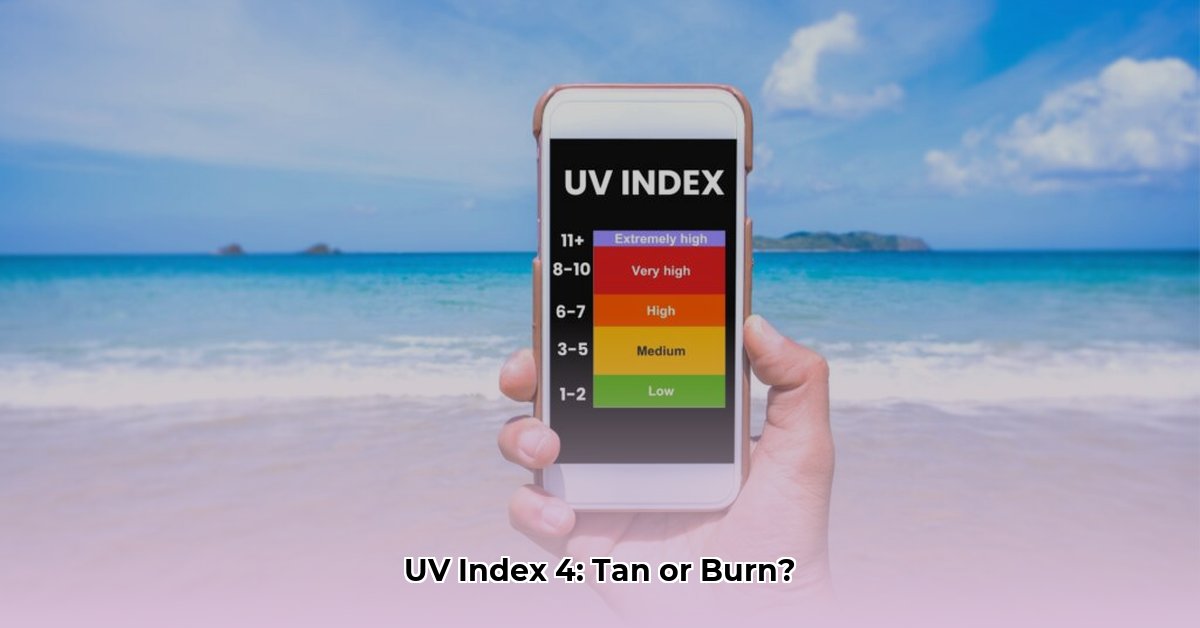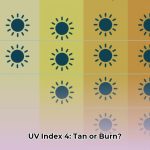Getting a tan in a UV index of 4 is possible, but it’s essential to prioritize sun safety. This guide provides a comprehensive overview of tanning at a UV index of 4, explaining the process, risks, and most importantly, how to protect your skin.
Understanding UV Index 4
A UV index of 4 falls within the “moderate” range. This signifies that while tanning is likely, there’s also a moderate risk of sunburn, especially for those with fairer skin. It’s crucial to take precautions to minimize potential harm.
What is the UV Index?
The UV index measures the strength of the sun’s ultraviolet (UV) radiation at a particular place and time. It ranges from 0 (low) to 11+ (extreme). A higher UV index indicates a greater risk of sunburn and other sun-related skin damage.
How Tanning Works
Tanning occurs in two stages: immediate and delayed. The immediate tan is a temporary darkening of the skin. The delayed tan, appearing over a few days, is your skin’s natural protective response to UV exposure, producing more melanin, the pigment that gives skin its color.
Skin Types and Tanning
Your skin type significantly influences how quickly you tan and your susceptibility to sunburn. Fairer skin (Types I and II) tends to burn more easily and tans less readily than darker skin (Types V and VI).
| Skin Type | Description | Tanning Response (UV Index 4) | Potential Burn Time (UV Index 4) |
|---|---|---|---|
| Type I | Very fair, light eyes, freckles likely | Minimal tanning, burns very easily | Likely less than 20 minutes |
| Type II | Fair, light eyes, burns easily | Tans minimally, burns easily | Probably around 20-30 minutes |
| Type III | Medium, light to medium eyes | Tans gradually, moderate burn risk | Possibly 30-45 minutes |
| Type IV | Olive, dark eyes | Tans easily, minimal burn risk | Probably 45-60 minutes |
| Type V | Brown, dark eyes | Tans deeply, rarely burns | More than 60 minutes |
| Type VI | Black, dark eyes | Tans very deeply, almost never burns | Burning is extremely unlikely (60+ minutes) |
These times are approximations. Actual burn times may vary due to individual factors and environmental conditions.
Factors Influencing Tanning Time
Beyond the UV index and skin type, other factors can affect how quickly you tan:
- Time of Day: UV radiation is strongest between 10 a.m. and 4 p.m.
- Altitude: Higher altitudes experience more intense UV radiation.
- Reflection: UV rays reflect off surfaces like water, sand, and snow, increasing exposure.
Safe Tanning Practices in UV Index 4
While a tan might seem appealing, remember it’s a sign of skin damage. Prioritize sun safety to minimize risks:
Sunscreen Application: A Step-by-Step Guide
- Choose Wisely: Select a broad-spectrum sunscreen with an SPF of 30 or higher, offering protection against both UVA and UVB rays.
- Apply Liberally: Use a generous amount, covering all exposed skin 15-30 minutes before sun exposure.
- Reapply Regularly: Reapply every two hours, or immediately after swimming or sweating.
Additional Sun Protection Measures
- Seek Shade: Limit direct sun exposure during peak hours.
- Protective Clothing: Wear a wide-brimmed hat, sunglasses, and protective clothing.
Risks of Sun Exposure
Excessive sun exposure can lead to:
- Sunburn: A painful inflammatory reaction to UV radiation.
- Premature Aging: Wrinkles, age spots, and leathery skin texture.
- Skin Cancer: Including melanoma, the most dangerous form.
Some studies suggest potential links between sun exposure and other health issues, although research is ongoing.
After-Sun Care
If you get sunburned:
- Cool Compresses: Apply cool compresses to soothe the skin.
- Moisturize: Use a moisturizing lotion containing aloe vera.
- Hydrate: Drink plenty of water.
Seek medical attention for severe sunburns with blistering, fever, or chills.
Alternative Tanning Methods
Self-tanner provides a safer alternative, giving you a tan without the risks of UV exposure.
Checking Your Local UV Index
Stay informed about the UV index in your area. Consult weather apps, websites, or local news for up-to-date information. This enables you to adjust your sun protection strategies accordingly.
Conclusion
Enjoy the sun responsibly by prioritizing safety. By understanding the UV index, your skin type, and practicing sun-safe behaviors, you can minimize risks while still enjoying outdoor activities.
FAQs
Q: Can I use sunscreen in a tanning bed?
A: No, sunscreen is not designed for tanning beds and may not offer adequate protection. The safest approach is to avoid tanning beds altogether.
Q: Does a cloudy day eliminate the need for sunscreen?
A: No, UV rays can penetrate clouds. Sunscreen is still necessary even on cloudy days, especially with a UV index of 4.
Q: Is there such a thing as a “safe” tan?
A: Any tan is a sign of skin damage. There’s no truly “safe” tan, but minimizing sun exposure and using proper protection can reduce the risks.
References
- American Academy of Dermatology (AAD)
- Skin Cancer Foundation
Disclaimer: This information is for educational purposes only and does not constitute medical advice. Consult a dermatologist for personalized guidance. Ongoing research continually updates our understanding of sun exposure and skin health.
- Wellness Fair Ideas for Work to Boost Employee Wellbeing - December 15, 2025
- Affordable Employee Wellness Fair Ideas for Any Budget - December 14, 2025
- Employee Wellness Programs Strategically Benefit Employee Health And Retention - December 13, 2025
















